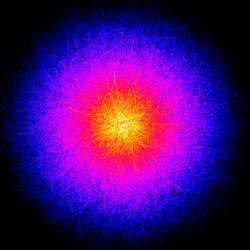Dark matter is held together by 'attractors'

The universe consists of a large amount of invisible matter - dark matter. We do not know what it is, but we know that it is there and that without dark matter there would be no galaxies, and hence stars, planets and life as we know it. The universe is filled with large structures that are dominated by dark matter and in these dark matter spheres or 'halos' the light emitting particles form stars and gas clumps. Recent studies show that these dark matter halos have so-called attractors, which preserve their shape. The results are published in Astrophysical Journal Letters.
"It is somewhat surprising that we do not understand why these dark matter halos look like they do. The dark matter particles only feel the pull of gravity so it should be simple to find out, for example, how their density changes when you move from the inner to the outer part. But no one has yet understood why the temperature and density of the dark matter has the form we observed", explains astrophysicist Steen Hansen, Dark Cosmology Centre at the Niels Bohr Institute at the University of Copenhagen.
Furthermore, it is not known whether there is a fundamental reason for the simple structure of the temperature and density of the halos, which are observed or whether their form is determined by the collisions and dramatic events they have been exposed to in the history of the universe, almost randomly.
Stars behave characteristically
As a star evolves you can measure its surface temperature and luminosity. Nearly all stars that are in the process of burning off their hydrogen fall into a main sequence with uniform states. This uniformity is an attractor for ordinary luminous particles because there is always a unique balance between radiation pressure and gravity as the hydrogen atoms fuse together to form helium.
If you take a star on the main sequence and 'knock' on it, so that it, for example, shines brighter for a short period than what the main sequence attractor says it should, (such a controlled change in conditions can be simulated on a computer, for example, by moving the energy in the star around a bit) then the star rushes back to the main sequence. This is characteristic for all attractors in nature.
Dark matter also behaves characteristically
Dark matter particles have no radiation pressure, so it was previously entirely unknown whether they could have a similar attractor and thereby explain why all of the dark matter halos look virtually the same.
"We have for the first time, through computer simulations, shown that dark matter halos have an attractor. We have found a very special relationship between the state of the temperature and the density of the dark matter from the inner part of the halo to the outer part," explains Steen Hansen, who has made the calculations together with two of his students, Diana Juncher and Martin Sparre.
The researchers created computer models of a wide range of different dark matter halos, all of which were in perfect balance. Then they 'knocked on' these structures so that they changed. They did so by moving the energy in them around a little bit, which you can do to stars in a computer model. But it turned out that all of the halos changed their state towards the same uniform shape. In this way dark matter halos are completely distinct from stars.
"When a star has exhausted its hydrogen, it moves away from the main sequence - it leaves its attractor. Since we have no indications that dark matter emits radiation or collide with each other, we believe that these halos will remain on their attractor forever", concludes Steen Hansen.
Source: University of Copenhagen



















